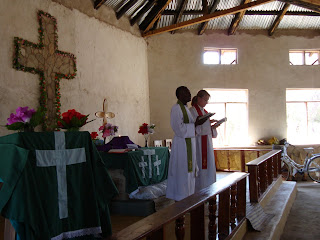Village #1: Tungamalenga

"A really progressive village," is how one well traveled friend has described Tungamalenga.
Of the twenty village congregations that comprise Tungamalenga Parish, Tungamalenga is considered the "main station." It has a large worship building with an unusual hexagonal design, a youth center with parish offices and space for meetings, the parsonage, and a clinic with both outpatient and inpatient wards. There are approximately 200 members in the congregation.
What's progressive about Tungamalenga? Situated on the road to Ruaha National Park, it gets more tourist traffic and commercial traffic than most Tanzanian villages. While homes do not have electricity or running water, a few businesses do. There are four camps or lodges in the area, providing lodging, restaurant and bar service, as well as day trips into the park for game drives.

The morning ritual for women and youth includes a trip to one of several communal water faucets. People line up their five gallon pails and empty cooking oil containers. One person washes the containers, another fills them with water. Women and strong children come and go, collecting the filled containers and carrying them on their heads back home for the daily washing and cooking.
Dr. Barnabas often reminds the children to have their mothers boil the water before drinking it.
One of the water stations is located between the two buildings of the clinic (just to the right of the building in the above photo). This is the 40 bed ward, an L shaped building with rooms for patients and also a delivery room. Patients may be cared for here up to 3 days before they must be released or transferred to a higher level facility.
This is one of the newly refurbished cabins at Tungamalenga Camp, where we usually stay. We love the location of the camp, within easy walking distance of the church, school and clinic.
In front of the main church building, the congregation has fashioned a heart enclosing the cross. This building has been under construction since 2003. First the foundation was dug, and a trench filled with large boulders collected by congregation members. Then walls of kiln dried red bricks went up--bricks made and laid by congregation members. Then the roof, with financial assistance from Shepherd of the Valley. A couple years ago, the cement floor was installed. Then last year, the raised altar area with its communion rail and new altar were completed. At our last visit, the exterior plastering was about 60% finished.
The village also has a thriving market and business district, a primary school with 600 children attending grades 1-7, a government clinic, and a sprawling area just outside town where residents cultivate plots of farm land.
Daily buses pass through town providing transportation to Iringa, several hours away.






Comments
Post a Comment